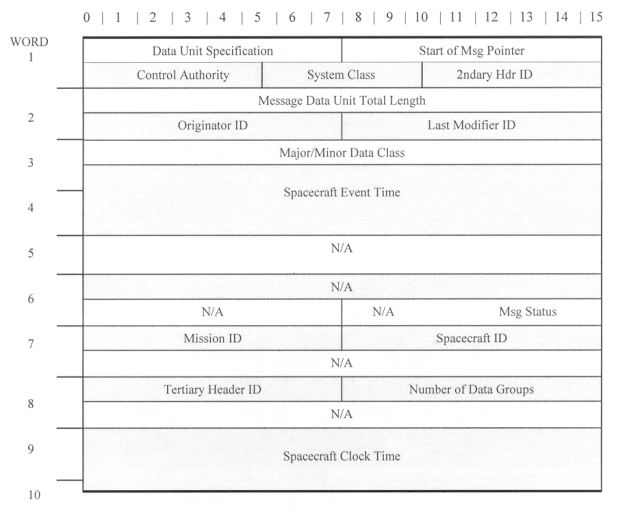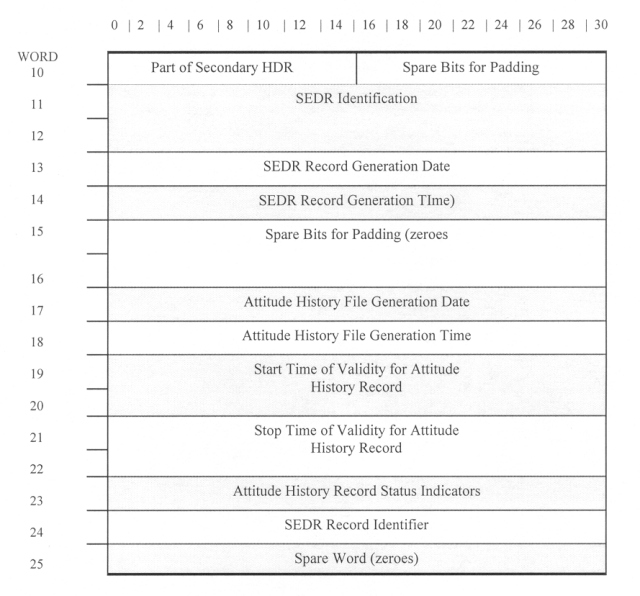Ulysses HISCALE Data Analysis Handbook
Appendix 8. Supplementary Experiment Data Records
A8.4 Detailed Interface Specification
A8.4.1 Overview of Structure and Organizationn
There will be only one file of SEDRs on each tape written for dissemination to the ULS PIs. (As a matter of consistency and predictability in operations, the DMT will limit the size of the SEDR file to that which will fit on a single reel of magnetic tape.) The SEDR file on tape shall terminate with two end-of-file tape markers. The layout of the SEDR file on tape is presented in Figure A8-1. There will be no internal tape labels on the SEDR tapes.

There will be two SEDR formats, integer or floating-point. Tertiary-SFDU-header word 24 of the first SEDR in the file shall identify which of the two formats shall be used for the remainder of the file. Details of this scheme are found in Section A8.4.2.
A8.4.2 Substructure Definition and Format
The SEDR shall consist of three SFDU headers followed by a block of the supplementary experiment data (Figure A8-2). Each word in an SEDR shall be 32-bits in length. The first word in the SEDR shall be the first 3 bits of the primary SFDU header. All words in each SEDR shall be counted consecutively from this first word. Thus, since the three SFDU headers take up the first through the 25th word in the SEDR, the actual supplementary experiment data will appear in the 26th through the 288th words in the SEDR.
In the case of an integer format SEDR, an additional record, the scale factor block (Figure A8-3) will appear as the first record on the SEDR.
| Figure A8-2 Data Block | Figure A8-3 Scale Factor Block |
 |
 |
SFDU Headers. The format of the primary and secondary SFDU headers for the SEDR is presented in Figure A8-4 and is specified in detail in Table A8-4. The format of the tertiary SFDU header for the SEDR is presented in Figure A8-5 and is specified in Table A8-5.
Figure A8-4 ULS SEDR primary and secondary SFDU headers

Table A8-4 ULS SEDR primary and secondary SFDU header definition
| Word | Bits | Description |
| 1 | 0-3 | Label Version Number - indicates the version of standard formatted data unit (SFDU. 0001 - Base Version Code (constant for ULS) |
| 1 | 4-5 | Character Set - indicates the character representation used within this record. 00 = binary type (constant for ULS) |
| 1 | 6-7 | Unit Structure Type - globally defines the gross structural characteristics of the data unit. 00 - (constant for ULS) |
| 1 | 8-15 | Start of Message Pointer - number of bytes to beginning of message |
| 1 | 16-21 | Control Authority - institution controlling the contents of the remainder of the data unit. 000101 = NASA JPL (constant for ULS) |
| 1 | 22-26 | System Classification - local system responsible for creating the secondary header |
| 1 | 27-31 | Secondary Header Identifier - identifies the secondary header type. 00010 = ULS (constant for ULS) |
| 2 | 0-15 | Message Unit Classification - total length of this record in bytes |
| 2 | 16-23 | Originator ID. Data records system - 4316 |
| 2 | 24-31 | Last Modifier ID. Data records system - 4316 |
| 3 | 0-15 | Major/Minor Data Class. Predict SEDR - 6016, Final SEDR = 6116, Special SEDR = 6216 |
| 3 4 |
16-31 0-15 |
Spacecraft Event Time (SCET) - time of validity of the SEDR record, elapsed seconds since Jan. 1, 1950 (UTC) |
| 4 | 16-31 | Fraction of a second of SCET, binary point assumed to the left of bit 16. (Integer/216 format) |
| 5 | 0-31 | Unused (zero fill) |
| 6 | 0-27 | Unused (zero fill) |
| 6 | 28 | Data Quality Flag - indicates if the data portion of this record is valid or not. 0=data valid; 1=data suspect, incomplete or invalid |
| 6 | 29 | Spacecraft Clock Flag - indicates if the spacecraft clock is valid or not. 0=SCLK is valid; 1= SCLK is missing, incomplete or invalid |
| 6 | 30 | Spacecraft Event Time Flag - indicates if the SCET value is valid or not. 0=SCET is valid; 1=SCET is missing, incomplete or invalid |
| 6 | 31 | Earth Received Time Flag - indicates if the ERT value is valid or not. 0=ERT is valid; 1=ERT is bad or missing |
| 7 | 0-7 | Mission ID. 0316=Ulysses |
| 7 | 8-15 | ULS Spacecraft ID=3716(5510) |
| 7 | 16-31 | Unused (zero fill) |
| 8 | 0-7 | Tertiary Header ID - indicates the type of tertiary header that follows the secondary header. 0316=data records system header |
| 8 | 8-15 | Number of Data Groups - 0116 |
| 8 | 16-31 | Unused (zero fill) |
| 9 | 0-31 | Spacecraft Clock Count (whole number counts with an implied binary point at the right) - computed from SCET. (decimal integer format) |
| 10 | 0-15 | Spacecraft Clock Count (fractional part of count with an implied binary point at the left). (decimal integer/216 format) |
Figure A8-5 ULS SEDR tertiary SFDU header

Table A8-5 ULS SEDR tertiary SFDU header definition
| Word | Bits | Description |
| 10 | 16-21 | Spare bits for padding (zeroes) |
| 11 | 0-31 | Spare word (zeroes) |
| 12 | 0-31 | Last four digits of the SEDR
Identification Number, integer format: MSTT where: M is the mission phase code S is the SEDR type code T identifies the tape sequence number (See Section A8.1.4.) |
| 13 | 0-31 | SEDR Record Generation Date, integer format. YYDDD (year, DOY) (e.g. 91300) |
| 14 | 0-31 | SEDR Record Generation Time, integer format. HHMMSS (e.g., 210756) |
| 15 16 |
0-31 | Spare words (zeroes) |
| 17 | 0-31 | Attitude History File Generation Date, integer format: YYDDD |
| 18 | 0-31 | Attitude History File Generation Time, integer format: HHMMSS |
| 19 | 0-31 | Start Date of Validity of Attitude Record, integer format:YYDDD |
| 20 | 0-31 | Start Time of Validity of Attitude Record, integer format: HHMMSS |
| 21 | 0-31 | Stop Date of Validity of Attitude Record, integer format: YYDDD |
| 22 | 0-31 | Stop Time of Validity of Attitude Record, integer format: YYDDD |
| 23 | 0-31 | Attitude Record Status Indicators
from Attitude History File, 3 digit decimal integer
format XYZ, where X=0 Actual Attitude History Data X=1 Predict Attitude History Data Y=0 delta-v accurate Y=1 delta-v inaccurate Z=0 delta-v provided Z=1 delta-v not provided |
| 24 | 0-31 | SEDR Record Identifier, integer
where 0=floating point record 1=scale factor record 2=integer record (See Section A8.4.2) |
| 25 | 0-31 | Spare Word (zeroes) |
SEDR Contents. The contents of the SEDR (i.e., what word represents which parameter) are presented in Table A8-6.
Next: A8.5 Glossary and A8.6 List of Acronyms and Abbreviations
Return to Appendix 8 Table of Contents
Return to HISCALE List of Appendices
Return to Ulysses HISCALE Data Analysis Handbook Table of Contents
Updated 8/8/19, Cameron Crane
QUICK FACTS
Mission End Date: June 30, 2009
Destination: The inner heliosphere of the sun away from the ecliptic plane
Orbit: Elliptical orbit transversing the polar regions of the sun outside of the ecliptic plane



